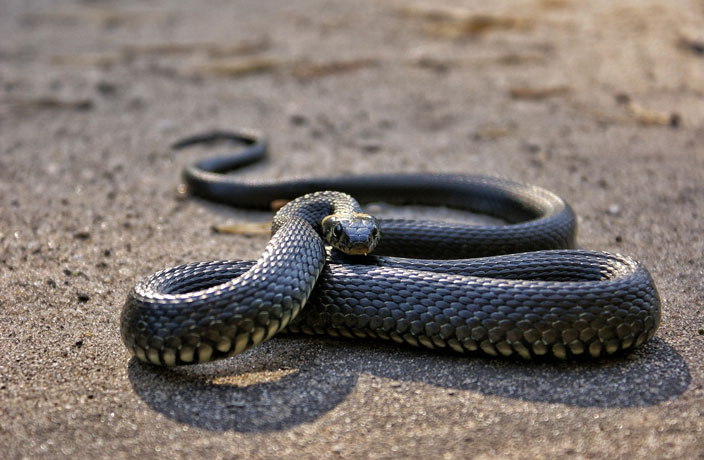How to Prevent Snake Bites
First of all, a snake bite can be prevented by wearing high boots and long, loose pants when hiking because most bites are on the lower legs. It’s never a good idea to go barefoot or wear sandals in snake country. Also, don’t reach your hands into unknown spaces or holes and wear leather gloves if handling wood or rock piles. If you see a snake, slowly back away. It’s important to teach curious children never to pick up or pursue snakes as well.
READ MORE: Venomous Snake Found Hiding in Dongguan Man's Car
Use a hiking stick if walking in brush and rattle the plants in front of you to give the snake a chance to escape (they’d usually prefer to flee rather than bite) – if you step on them or surprise them, they may bite. Stay on the trail rather than venture off because they often will hide in the brush. When crossing a log or stone on your path, step on it rather than over it, in case a snake is hiding behind it. It’s important to reiterate that you should never grab or pursue snakes. Many bite victims are snake hunters (even though they’re ‘professional’). This should also go without saying, but don’t walk in the woods or pursue snakes when drinking alcohol as this is another source of bites – one more reason not to drink alcohol as people do stupid things when drinking. Don’t ever handle snakes, even dead or seemingly dead ones that can still bite.
How to Treat Snake Bites
If a snake bites you, it most certainly is a medical emergency, so get to a hospital as soon as possible. Antivenin is the definitive treatment and can only be given in a hospital by injection, so call 120 or get there quickly. If bitten in water or tall weeds, some people may not know that they are actually bitten. Some bites will have two puncture marks, redness, swelling or intense pain around the wound. Wash the wound with soap and water if possible.
Some bites are ‘dry,’ meaning that no venom was released and you just have a puncture wound. If venom is released, then there are two main categories of venom. Some affect the nervous system, causing many different symptoms from dizziness or nausea to death, while other venoms affect our blood, predisposing us to internal bleeding.
WATCH: 2-Meter Snakes Caught by Bare-Handed Guard in Shenzhen
Remove rings or jewelry immediately after you’ve been bitten as it may become tight if the bite area swells up. If vomiting, the victim should lie on their side so the vomit can drain out without choking them. Try to remember the snake’s appearance or take a picture of it from a distance; however, the type of snake can often be diagnosed from the symptoms so it’s not so important. Better not to pursue it and risk another bite. Sometimes it’s recommended to immobilize the leg to prevent blood circulation from spreading the venom. If you’re close to transport , then this is ok, but if not, it’s better to figure out the fastest way to a hospital and get there, even if it means walking on the bitten leg. Time is essential, and you don’t want to wait to see if you get worse.
As for what not to do? Avoid using a tourniquet! These are more harmful than doing nothing and can result in the leg (or arm) needing to be amputated later. Do not cut the bite or attempt to suck out the venom with your mouth or snake kits. Avoid folk remedies, ointments or ‘snake stones’ (which are meant to neutralize venom, but are not useful). Avoid drinking alcohol for pain relief because it can cause more trouble with blood flow, and don’t take pain medicine with anti-inflammatory action like Fenbid (ibuprofen and this whole family of medicines). Only acetaminophen (paracetamol or ’Tylenol’) is ok for pain. Lastly, don’t use ice or electric currents on the wound.

Image via Pexels
Venomous Victim?
It’s important to note that you should seek medical attention for any snake bite. But while it can be difficult to tell the difference between a venomous and nonvenomous snake bite, the puncture marks are an indicator. A bite from a venomous snake leaves two clear puncture marks, while nonvenomous snakes often show two rows of teeth marks. Nonvenomous bites can still lead to skin infections and necrosis, so don’t take any chances.
READ MORE: Venomous Snake Under Shared Bike Seat Bites User in Guangzhou
[Cover image via Pexels]






















0 User Comments